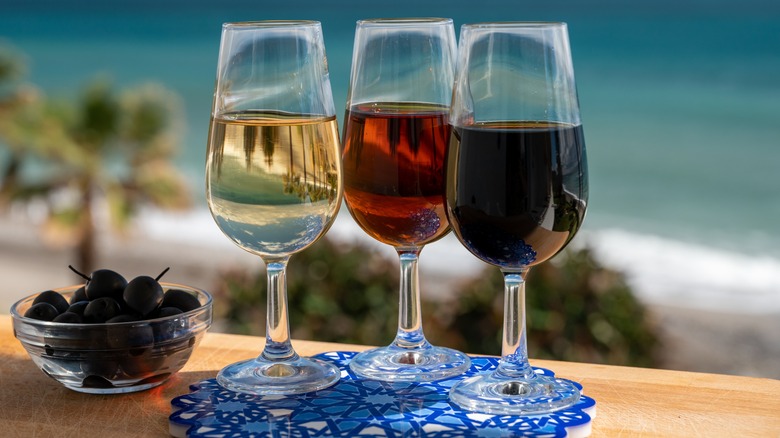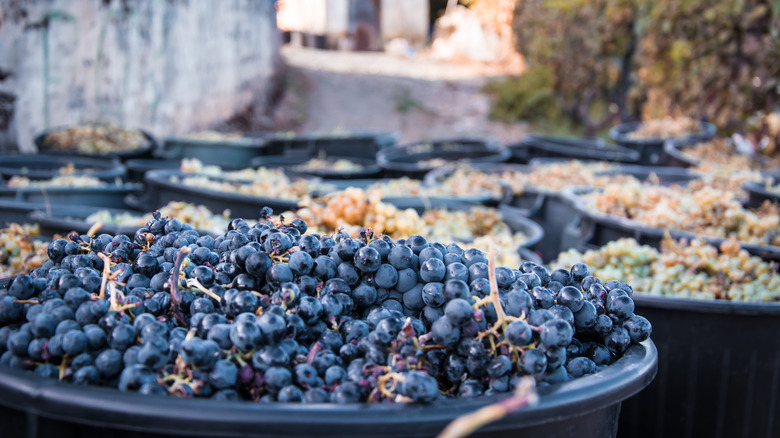The Key Difference Between Sherry And Port, Beyond Color
Perhaps you have noticed port as an ingredient in a holiday cheese ball and sherry being used in cocktails, or maybe you have seen sherry and port both included on a dessert wine list. Both of these drinks fall into the category of fortified wines — meaning that a distilled spirit is added to the fermented grape juice, increasing the alcohol content and its shelf-life. Depending on when the spirit is added, it will halt fermentation so that not all the sugar is converted into alcohol, resulting in a sweeter drink. These two alcoholic beverages also have specific standards for how and where they can be made, meaning these grape-based wines are quite different.
The color can sometimes distinguish them — port typically comes in a few different hues of red while sherry ranges from yellow to amber to deep brown. That's because often — though not always — port is made from certain red grapes, and sherry is made from specific white grapes. This is a helpful way to begin to think about the different flavor profiles.
Even more important, though, is the fact that port must come from the Douro Valley in Portugal, which is near the city of Porto, whereas true sherry can only be made in Jerez de la Frontera in the Andalusia region of Spain. Port-style wines can be made elsewhere, but those types are not considered true port. Similarly, wines made in a sherry style are produced globally, but authentic sherry is designated by a Jerez DO label (Denominación de Origen) and specifies that it is "Jerez-Xérès-Sherry," notes Brittanica.
Sherry and port are made differently
For both sherry and port, it all starts with the grapes. Port can technically be made with around 80 varieties of the fruit, but the most commonly used are touriga nacional, touriga francesa, tinta cao, tinta barroca, and tinta roriz, the last also commonly known as tempranillo. The grapes used to make port are typically handpicked and then crushed in wide stone or concrete tanks called lagers. The juice is then fermented with yeast, but halted at a specific point with the addition of a spirit like aguardente — a type of grape-based, Portuguese brandy. Legally, port must have an alcohol content of at least 17.5%, but is usually found at around 20%.
Sherry, on the other hand, begins with palomino, Pedro Ximénez, or moscatel grapes, all of which are white. For dryer sherries, the grapes are immediately pressed after harvesting, whereas the grapes for sweeter sherries are dried first to concentrate the flavors before pressing. Traditionally, sherries go through a natural fermentation process. This means that the rate of fermentation is determined by the climate, though modern producers will introduce heat to speed up the process, too. The desired style of sherry determines how much of and at what point the fortifying neutral spirit is added, with the final alcohol content typically ranging from 16% to 18%.
However, these fortified wines are not done yet. For both port and sherry, different aging processes are then used to create distinct final products.
Aged like a fine port wine
The two most common types of port are ruby and tawny. Ruby ports are aged for the least amount of time — up to two-and-a-half years — and see the lowest amount of contact with wood to retain bright, fruity flavors and more vibrant colors. Aging takes place in large oak barrels or stainless steel basins.
On the other hand, tawny port is aged in small barrels to increase contact with the wood, and thus, oxygen. Flavors can vary significantly due to the three- to 40-year aging process, but they usually tend to lean in a nutty, citrus-forward direction, and the color deepens to a reddish-brown. Vintage ports hold the top shelf. They are made only in years that have exceptional grape yields, and are aged over decades to develop intrigue and richness.
White port is the exception to the rule as it uses a blend of white grapes like malvasia fina, gouveio, viosinho, códega do larinho, moscatel galego branco, and rabigato. It can be made in bright, dry, youthful styles or aged for decades to develop deep complexity.
The solera method makes sherry special
One of the things you made not know about sherries is that nearly all are aged using the solera method wherein a series of barrels are stacked vertically. The wines from the most recent harvests are placed at the top, and the oldest are found at the bottom. As matured sherry is pulled from the bottom barrels, then all the younger sherries filter down to refill them, while the upper barrels are then topped off with the newest batch. This means that every bottle is blending from a range of years.
Dry sherries use palomino grapes, with fino and manzanilla being the driest of the bunch. During aging, a layer of natural yeast called flor forms across the top of the liquid, which limits oxidation and creates a nutty, saline, and herbal flavor profile. Amontillado and oloroso sherries are still dry, but they do see intentional oxidation — the flor dies off in amontillado sherry and oloroso is not aged under flor; this treatment tips the taste in a sweeter direction.
Sweet sherries are typically named for the grapes in them — moscatel or Pedro Ximénez. Because the grapes are left to dry, the flavors become intensely concentrated and sweet. They still go through aging in the barrel-focused solera method, but the result is more syrupy and viscous. Golden-hued moscatel tends to be honeyed, fruity, and floral, while deep brown Pedro Ximénez leans more jammy with notes of cocoa and coffee. Cream sherries are made by blending either of these varieties with oloroso.
Port and sherry can be enjoyed with more than just dessert
Yes, sweet wines are delightful with sweet dishes. When paired thoughtfully, the side-by-side flavors actually provide balance without becoming cloying. When it comes to the desserts, try ruby port with fruit-forward treats like cherry pie; tawny port with dishes that have nuts or caramel; and a special occasion vintage port with bold chocolate.
Sweet white port pairs well with strawberries, lemon, cream, and white chocolate. As well, moscatel is delightful with fruit, cream, or egg-based desserts, while Pedro Ximénez sings alongside darker flavors like those in chocolate desserts, tiramisu, or even poured directly over vanilla ice cream.
The driest sherries are commonly served alongside salty snacks, olives, fried seafood, and raw oysters; dry white port can be served in a similar way. Sweeter amontillado sherry can make a great pairing for rich, savory, and meaty dishes, as can aged ports. Tawny port loves roasted nuts, salty or smoked cheeses, and cured meats, and sweeter aged ports are classically paired with bold cheeses like stilton, roquefort, and cambozola. If you think syrupy sherries are far too sweet for a savory pairing, think again — sherry can also stand up to those funky cheeses or creamy pâté.





